Prefabricated steel micropiles allow the ground and foundations of an existing building to be consolidated in the safest and least invasive way possible.
The failure of masonry foundations and the instability of buildings
One of the main causes for the formation of injuries and disruptions in the walls there are sagging of the foundations or foundations, or more precisely of the land on which they download the stresses transmitted by the structure above.
The most affected are normally the historic buildings or in any case old, with a structural system made up of load-bearing walls of stone, bricks or squared stone ashlars with underlying continuous foundations Very superficial.
However, the most vulnerable of all is one house without foundations its a clayey soila very frequent situation for example in traditional rural construction in Emilia Romagna.
Injuries due to foundation failure
Land subsidence produces a crack pattern very characteristic, of which we see an excellent one representation in this scheme.
Diagram of a failure due to foundation failure
Typical ones appear to the right and left of the sunken portion diagonal cutting injurieseasily recognizable byinclined trend according to an angle directly related to the construction technique of the masonry: from approx 45° from the brick walls in a workmanlike manner almost 90° of the disordered walls of stones.
Another clear symptom of foundation failure is the depressions in the floor of the rooms on the ground floor, normally located precisely in correspondence with the most affected areas.
Seasonal trend of foundation settlements
Disturbances due to foundation failures are also characterized by a marked seasonal trenda fact which further contributes to their easy identification.
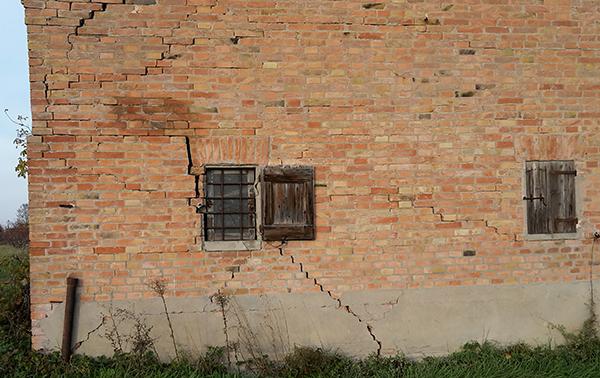 Diagonal shear lesions typical of foundation failures
Diagonal shear lesions typical of foundation failures
In fact in summer months the soil, dry and devoid of water due to the scarcity of rain and the lowering of surface water tables, it tends to retreat, accentuating theextent of the lesions pre-existing; while in autumn and winterbecoming saturated with water, increases in volume causing aapparent reduction of the crack pattern.
Methods of consolidation of foundations for masonry buildings
L’only way to solve the problem of structural failures in the house, once the problems have been clarified cause with a structural monitoring for a period of at least a year (or better yet two, corresponding to two entire seasonal cycles) is to proceed to reinforcement of existing foundations or the ground immediately below.
In fact, if the origin of the instability is not completely removed, simply compensating pre-existing lesions with mortar, reinforced seams or unstitching, within a short time the crack pattern tends to reform exactly in the same points.
 Damage due to foundation failure in a stone ashlar wall
Damage due to foundation failure in a stone ashlar wall
They exist numerous methods of foundation consolidation.
One of the oldest is the foundation underlaying which, deepening and widening the basis of the foundation continues, restarts i vertical loads transmitted from the building on a larger surface areadecreasing the stresses per square centimeter, and also reaches deeper layers of soil, which are normally more solid and compact.
However, it is a method now uncommon normally reserved for the restoration of listed buildingsbecause it is very expensive and requires a long time and very expert labor.
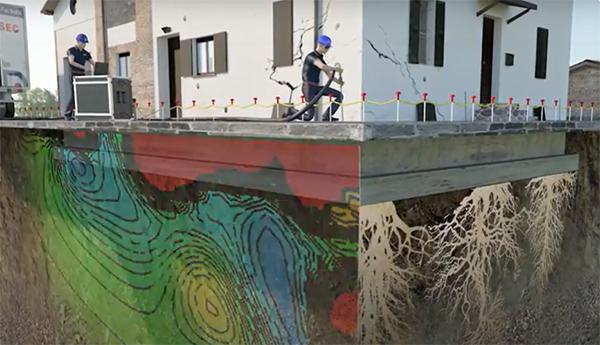 Consolidation of the foundation soil with resin injections, by geosec
Consolidation of the foundation soil with resin injections, by geosec
Another system instead involves the execution of resin injections into the groundso constipate it and consolidate it without intervening directly on the foundations of the house: the SEE&SHOOT technology® of the company Geosec it is based precisely on this principle.
Compared to other methods, it has its advantages advantages to request processing times and ainvasiveness significantly lower, at a relatively low cost.
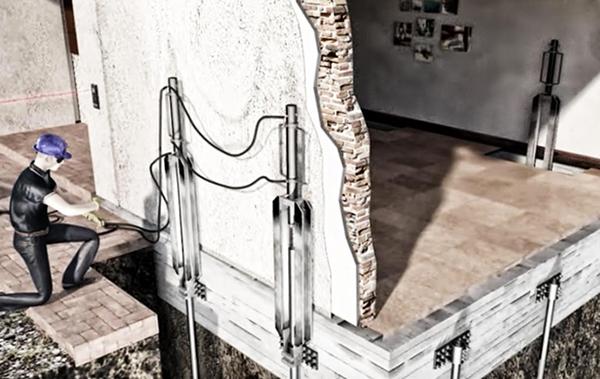 Underpinning with prefabricated micropiles, by geosec
Underpinning with prefabricated micropiles, by geosec
A final solution involves the construction of a underfoundation of micropiles.
Consolidation of the foundations with prefabricated micropiles
The main objectives there are two: constipate the ground, increasing its compressive strength, or reach i deeper soilsless poor and with more lift.
The first objective is normally achieved with a Berliner, that is, one pile bulkhead almost always drilled on site, widely used especially for the construction of retaining walls or the consolidation of sloping terrain.
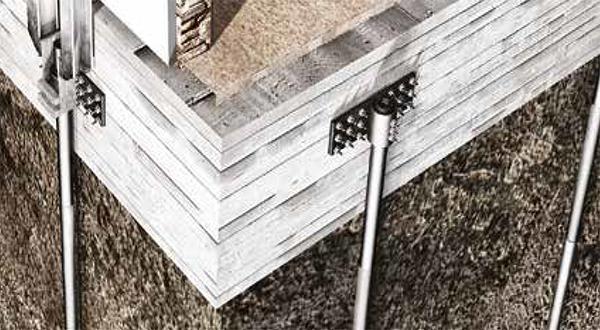 Underpinning with Groundfix® micropiles by Geosec
Underpinning with Groundfix® micropiles by Geosec
In existing buildings, however, there is a tendency to use piles for foundations prefabricatedto reduce the invasiveness of the operation and in particular the vibrations arising from the execution of micropali trivellatiwhich could aggravate the pre-existing crack pattern: consolidation with micropiles must in fact be carried out prima to compensate for damage to the masonry.
An example of prefabricated micropiles
GROUNDFIX® at Geosec it’s a type of active pilingi.e. not intended to counteract the horizontal thrusts (and therefore not suitable for the consolidation of slopes and retaining walls) based on prefabricated steel piles for foundations, assembled on site and pressure fixtures into the ground by means of hydraulic jacks.
 Foundation curb complementary to micropiles, by Geosec
Foundation curb complementary to micropiles, by Geosec
The poles then come anchored to the pre-existing foundation with steel plates and special high-resistance mortars.
They cannot therefore be used for all cases, as they require a contrast structure and adequate anchor points for the plates.
Their specific field of use is therefore buildings with reinforced concrete foundations to pay o reverse beam: in other cases it is therefore necessary to create concrete underlayments or a foundation curb in reinforced concrete.
L’driving of micropiles it is also minimally invasive, i.e. it does not require excavation under the foundation or the removal of soil, and it does not involve the creation of vibrations.
Technical specifications of foundation micropiles
Of course the number, technical specifications and distance between foundation piles should be carefully calculated based on the fundamental characteristics of the building, such as the plan shapethe number of piles foreseen, the loads and obviously the type and the mechanical characteristics of the land.
 Metal plate with anchor bolts for anchoring the micropile, by Geosec
Metal plate with anchor bolts for anchoring the micropile, by Geosec
To ensure the maximum adaptability to different scenarios, the GROUNDFIX poles® are made up of modular elements of S355J2 steel easily dry assembled with a diameter of 63, 76 or 114 mm; while the plates they are made of S355 type steel, fixed to the pre-existing foundations with threaded rods (anchor bolts) with a diameter of 12 mm for expansion anchoring in galvanized steel with nut and oversized washer. Each plate can carry up to 18 anchors.
Main phases of foundation consolidation with prefabricated micropiles
Foundation consolidation with micropiles GROUNDFIX® requires four main phases of work.
After the preliminary inspection and the executive planning of the operation, the first operation is the preparation of the construction sitewith the execution of a possible excavation near the pre-existing foundation to guarantee a better technical operation and workforce logistics.
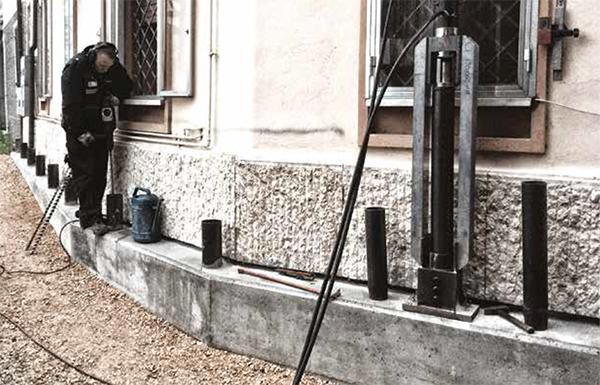 Driving micropiles, by Geosec
Driving micropiles, by Geosec
Subsequently, if the pre-existing foundation offers adequate guarantees of resistance and reliability, we move on to fixing the plates of steel appropriately sized to accommodate the connection of the thrust system and the connection between the micropiles and the foundations of the house.
At this point the insertion castle and we proceed with the insertion of the sequential modular elements, i.e. the tubes for micropiles which constitute the consolidation sub-foundation. Each segment is therefore positioned thanks to the thrust of the driving system and joined to the previous one to form a single structural element.
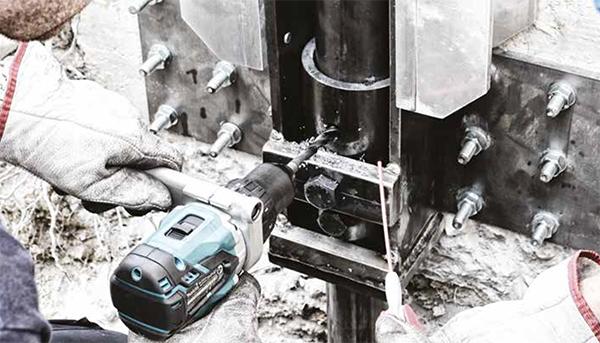 Anchoring the micropile to the pre-existing foundations, by Geosec
Anchoring the micropile to the pre-existing foundations, by Geosec
To avoid imbalances or imbalances that could compromise the success of the operation, the thrust values and the progress of the operation come monitored constantlyif necessary also acting on multiple micropiles at the same time.
Once you reach the design depth o to rejection pressurei.e. such a level of soil compaction as to no longer allow any additional insertion of the micropile, the pile is connected to the pre-existing foundation through the specially prepared anchoring plate and the work is completed cutting the pole part excess.
End of article
THE EDITORIAL TEAM RECOMMENDS
The company is able to provide, upon request, an intervention proposal, which will be followed in detail in all its executive phases, with the relevant guarantees.
You can contact the technicians without obligation Geosec Srl so we can agree on a first free inspection in every area of Italy for the preliminary verification of the state of the places and the instability.
Source: www.lavorincasa.it


